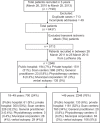Epidemiology of Young Stroke in the Ludhiana Population-Based Stroke Registry
- PMID: 35342262
- PMCID: PMC8954304
- DOI: 10.4103/aian.aian_711_21
Epidemiology of Young Stroke in the Ludhiana Population-Based Stroke Registry
Abstract
Objective: The objective of the study was to determine incidence, risk factors, and short-term outcomes of young stroke in Ludhiana city, Northwest India.
Methods: Data were collected on first-ever stroke in patients of age ≥18 years, from hospitals, diagnostic imaging centers, general practitioners, and municipal corporation during March 2011-March 2013 in Ludhiana city, using the World Health Organization Stepwise Approach to Surveillance (WHO STEPS). Outcome was documented using the modified Rankin Scale at 28 days.
Results: Of 2948 patients, 700 (24%) were in the age group 18-49 years. Annual incidence in this age group was 46/100,000 person-years (95% confidence interval [CI], 41-51/100,000). Hypertension (84%), diabetes mellitus (48%), and atrial fibrillation (AF) (12%) were found more common in >49 years age group, as compared with 18-49 years age group. Drug abuse (8.7% vs. 6% in age >49 years; P = 0.04) and tobacco intake (8.7% vs. 5.6% in age >49 years; P = 0.02) was more common in young people, that is, 18-49 years age group in comparison to older patients, >49 years age group. Recovery was better in younger subjects (60% vs. 46% in age >49 years P < 0.001). In a multivariable analysis, younger people were more often literate (odds ratio [OR] 2.52; 95% CI, 1.68-3.77; P < 0.001), employed (OR 3.92; 95% CI, 2.20-5.21; P < 0.001), and 374 (60%) had good clinical outcome, modified Rankin Scale <2 at 28 days follow-up as compared with 938 (46%) older patients (OR 1.52; 95% CI, 1.15-2.00; P = 0.003).
Conclusion: Hypertension, diabetes mellitus, drug addiction, and tobacco intake were significantly associated with young stroke. Outcome was also better in younger people.
Keywords: Population-based registry; World Health Organization Stepwise Approach to Surveillance Approach (WHO STEP); lower-and middle-income countries; young stroke.
Copyright: © 2006 - 2022 Annals of Indian Academy of Neurology.
Conflict of interest statement
There are no conflicts of interest.
References
-
- Putaala J, Metso AJ, Metso TM, Konkola N, Kraemer Y, Haapaniemi E, et al. Analysis of 1008 consecutive patients aged 15 to 49 with first-ever ischemic stroke: The Helsinki young stroke registry. Stroke. 2009;40:1195–203. - PubMed
-
- Renna R, Pilato F, Profice P, Della Marca G, Broccolini A, Morosetti R, et al. Risk factor and etiology analysis of ischemic stroke in young adult patients. J Stroke Cerebrovasc Dis. 2014;23:e221–7. - PubMed
-
- Kissela B, Schneider A, Kleindorfer D, Khoury J, Miller R, Alwell K, et al. Stroke in a biracial population: The excess burden of stroke among blacks. Stroke. 2004;35:426–31. - PubMed


